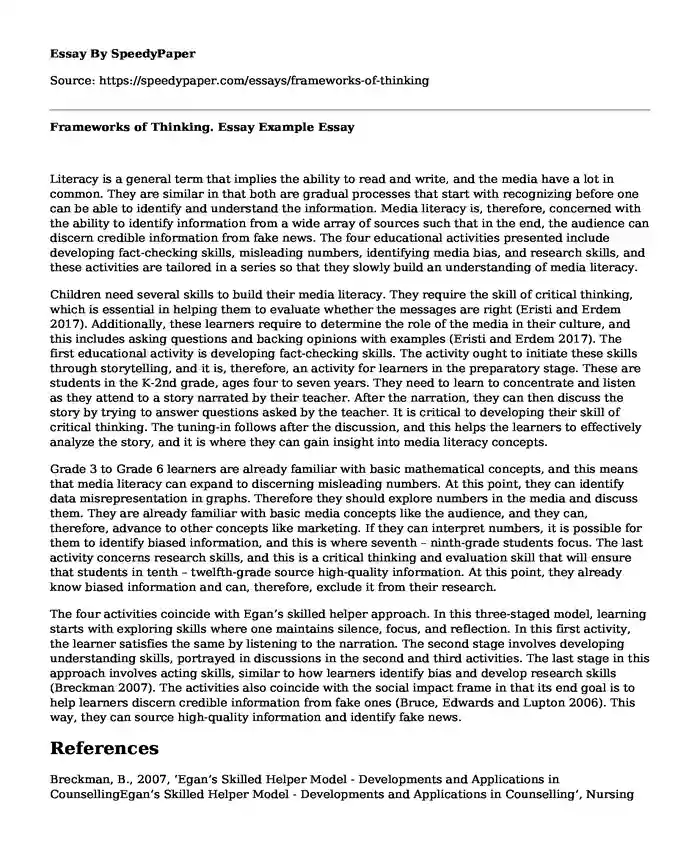
| Essay type: | Cause and effect essays |
| Categories: | Learning Knowledge Media Child development |
| Pages: | 3 |
| Wordcount: | 614 words |
Literacy is a general term that implies the ability to read and write, and the media have a lot in common. They are similar in that both are gradual processes that start with recognizing before one can be able to identify and understand the information. Media literacy is, therefore, concerned with the ability to identify information from a wide array of sources such that in the end, the audience can discern credible information from fake news. The four educational activities presented include developing fact-checking skills, misleading numbers, identifying media bias, and research skills, and these activities are tailored in a series so that they slowly build an understanding of media literacy.
Children need several skills to build their media literacy. They require the skill of critical thinking, which is essential in helping them to evaluate whether the messages are right (Eristi and Erdem 2017). Additionally, these learners require to determine the role of the media in their culture, and this includes asking questions and backing opinions with examples (Eristi and Erdem 2017). The first educational activity is developing fact-checking skills. The activity ought to initiate these skills through storytelling, and it is, therefore, an activity for learners in the preparatory stage. These are students in the K-2nd grade, ages four to seven years. They need to learn to concentrate and listen as they attend to a story narrated by their teacher. After the narration, they can then discuss the story by trying to answer questions asked by the teacher. It is critical to developing their skill of critical thinking. The tuning-in follows after the discussion, and this helps the learners to effectively analyze the story, and it is where they can gain insight into media literacy concepts.
Grade 3 to Grade 6 learners are already familiar with basic mathematical concepts, and this means that media literacy can expand to discerning misleading numbers. At this point, they can identify data misrepresentation in graphs. Therefore they should explore numbers in the media and discuss them. They are already familiar with basic media concepts like the audience, and they can, therefore, advance to other concepts like marketing. If they can interpret numbers, it is possible for them to identify biased information, and this is where seventh – ninth-grade students focus. The last activity concerns research skills, and this is a critical thinking and evaluation skill that will ensure that students in tenth – twelfth-grade source high-quality information. At this point, they already know biased information and can, therefore, exclude it from their research.
The four activities coincide with Egan’s skilled helper approach. In this three-staged model, learning starts with exploring skills where one maintains silence, focus, and reflection. In this first activity, the learner satisfies the same by listening to the narration. The second stage involves developing understanding skills, portrayed in discussions in the second and third activities. The last stage in this approach involves acting skills, similar to how learners identify bias and develop research skills (Breckman 2007). The activities also coincide with the social impact frame in that its end goal is to help learners discern credible information from fake ones (Bruce, Edwards and Lupton 2006). This way, they can source high-quality information and identify fake news.
References
Breckman, B., 2007, ‘Egan’s Skilled Helper Model - Developments and Applications in CounsellingEgan’s Skilled Helper Model - Developments and Applications in Counselling’, Nursing Standard, 21(19), pp.30-30.
Bruce, C., Edwards, S. and Lupton, M., 2006, ‘Six Frames for Information Literacy Education: a conceptual framework for interpreting the relationships between theory and Practice’, Innovation in Teaching and Learning in Information and Computer Sciences, 5(1), pp.1-18.
Eristi, B. and Erdem, C., 2017, ‘Development of a Media Literacy Skills Scale’, Contemporary Educational Technology, 8(3).
Cite this page
Frameworks of Thinking. Essay Example. (2023, Aug 01). Retrieved from https://speedypaper.com/essays/frameworks-of-thinking
Request Removal
If you are the original author of this essay and no longer wish to have it published on the SpeedyPaper website, please click below to request its removal:
- My Techniques and Tips to Making Oneself Study - Free Essay in Education
- Free Essay with a Language Development Lesson Plan
- Essay Sample on Similarities and Differences Between 'The Hate You Give' Movie and Book
- Essay Sample on Research Process Description on the Last Supper
- Raising Bertie: Movie Analysis Essay
- Paper Example: The Preeminence of Teachers
- Be Careful About What You Post Online - Essay Sample
Popular categories




